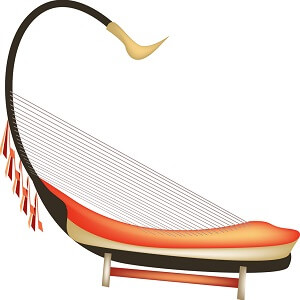Saung
 An arched harp, called a saung-gauk, with a long neck carved from a tree root, from which 13 silk strings would have extended from tuning pegs to the body. The top of the body is covered with animal hide, pierced in four places. It is painted black and gilt and decorated with stylised flower heads inlaid with mica (?), as well as a stylised bodhi tree leaf at the ends of the string bar.
An arched harp, called a saung-gauk, with a long neck carved from a tree root, from which 13 silk strings would have extended from tuning pegs to the body. The top of the body is covered with animal hide, pierced in four places. It is painted black and gilt and decorated with stylised flower heads inlaid with mica (?), as well as a stylised bodhi tree leaf at the ends of the string bar.
The stand is similarly decorated with flower heads on the flat base and has two scrolled uprights on which the harp sits when not being played. The saung-gauk is the national musical instrument of Burma and evidence exists of it being continuously played since the 8th century, predominantly in the chamber music of the Royal Court.
The harp has a boat-shaped resonator decorated with gilt, red and black, and a long arching arm protruding from one end. Strings are fitted between the sounding board and the bottom third of the arm. The top of the arm is leaf-shaped and encrusted with mirrors. With matching gilt, red and black cradle stand, on which the resonator rests. The saùng-gauk is the national musical instrument of Burma and evidence exists of it being continuously played since the 8th century, predominantly in the chamber music of the Royal Court. Its distinctive curved neck is traditionally made from the roots of the sha tree, which grow in a natural arc. The leaf-shaped tip of the neck is probably a representation of the leaf of the Bodhi tree, under which Buddha was said to have achieved Enlightenment. The instrument is held in the lap and played with both hands.